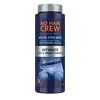What's inside
What's inside
 Key Ingredients
Key Ingredients

 Benefits
Benefits

 Concerns
Concerns

 Ingredients Side-by-side
Ingredients Side-by-side

Water
Skin ConditioningUrea
BufferingCetearyl Alcohol
EmollientIsopropyl Myristate
EmollientPotassium Thioglycolate
Calcium Hydroxide
BufferingCeteareth-20
CleansingPropylene Glycol
HumectantCamellia Sinensis Leaf Extract
AntimicrobialPanax Ginseng Root Extract
EmollientSpirulina Maxima Extract
SmoothingLaminaria Digitata Extract
Skin ProtectingFucus Vesiculosus Extract
EmollientAscophyllum Nodosum Extract
Skin ConditioningPorphyra Umbilicalis Extract
Skin ConditioningRosmarinus Officinalis Leaf Extract
AntimicrobialHelianthus Annuus Seed Oil
EmollientPotassium Hydroxide
BufferingAcrylates Copolymer
Glycerin
HumectantGluconolactone
Skin ConditioningCalcium Gluconate
HumectantSodium Chloride
MaskingPotassium Sorbate
PreservativeSodium Benzoate
MaskingParfum
MaskingWater, Urea, Cetearyl Alcohol, Isopropyl Myristate, Potassium Thioglycolate, Calcium Hydroxide, Ceteareth-20, Propylene Glycol, Camellia Sinensis Leaf Extract, Panax Ginseng Root Extract, Spirulina Maxima Extract, Laminaria Digitata Extract, Fucus Vesiculosus Extract, Ascophyllum Nodosum Extract, Porphyra Umbilicalis Extract, Rosmarinus Officinalis Leaf Extract, Helianthus Annuus Seed Oil, Potassium Hydroxide, Acrylates Copolymer, Glycerin, Gluconolactone, Calcium Gluconate, Sodium Chloride, Potassium Sorbate, Sodium Benzoate, Parfum
 Reviews
Reviews

Ingredients Explained
These ingredients are found in both products.
Ingredients higher up in an ingredient list are typically present in a larger amount.
Parfum is a catch-all term for an ingredient or more that is used to give a scent to products.
Also called "fragrance", this ingredient can be a blend of hundreds of chemicals or plant oils. This means every product with "fragrance" or "parfum" in the ingredients list is a different mixture.
For instance, Habanolide is a proprietary trade name for a specific aroma chemical. When used as a fragrance ingredient in cosmetics, most aroma chemicals fall under the broad labeling category of “FRAGRANCE” or “PARFUM” according to EU and US regulations.
The term 'parfum' or 'fragrance' is not regulated in many countries. In many cases, it is up to the brand to define this term.
For instance, many brands choose to label themselves as "fragrance-free" because they are not using synthetic fragrances. However, their products may still contain ingredients such as essential oils that are considered a fragrance by INCI standards.
One example is Calendula flower extract. Calendula is an essential oil that still imparts a scent or 'fragrance'.
Depending on the blend, the ingredients in the mixture can cause allergies and sensitivities on the skin. Some ingredients that are known EU allergens include linalool and citronellol.
Parfum can also be used to mask or cover an unpleasant scent.
The bottom line is: not all fragrances/parfum/ingredients are created equally. If you are worried about fragrances, we recommend taking a closer look at an ingredient. And of course, we always recommend speaking with a professional.
Learn more about Parfum